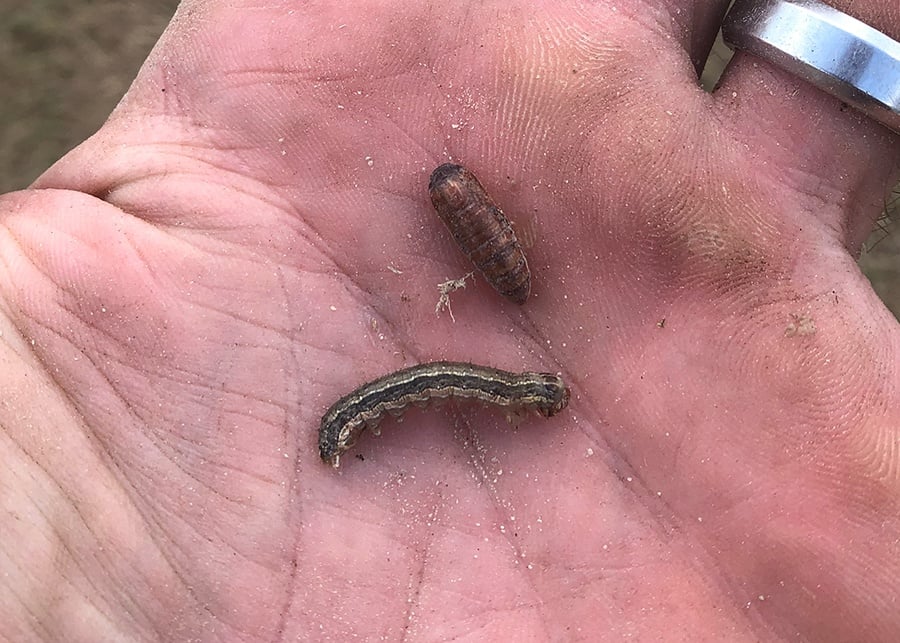

Fall Armyworms in Lawns - Identification & Treatment


From July to first frost in autumn,
install new sod with preventative insecticide for fall armyworms.
If you live in the Southeast (even as far north as North Carolina and Tennessee) and love your lawn, please scout for fall armyworms (FAW) daily from July to first frost.
Fall armyworms are not indigenous to our area and cannot overwinter here. They are the larval of a subtropical moth that migrate up here from the gulf coast and tropics. Their arrival is usually around midsummer, so be on alert for FAW activity every year from July until first frost.
"Armyworms" get their name from their behavior of moving across lawns in an army-like fashion; they aren't really worms at all - they're caterpillars. We'll explain everything you need to know about fall armyworms in this blog, including how to get rid of them.
Fall Armyworms in New Sod
Fall armyworms love new sod above everything else, but they will eat established sod too.
Their culinary propensity for new sod makes it appear that these creatures arrived with new sod, but lawn care experts and extension specialists are familiar with this problem and know that fall armyworms are already on site before new sod is laid.
New sod is like a fresh buffet spread out before them. Fall armyworms especially love new sod and newly seeded lawns because there is plenty of water, plus new growth is tender and juicy for them to chew.
NC State University writes about FAW damage in new sod. See fourth paragraph under "Damage."
We apply preventative insecticide to make sure our sod is clean and free of this pest. It wears off in 15 to 30 days after harvest, so if you have a new lawn from sod or seed, be sure to apply preventative insecticide to protect the curb appeal of your lawn.
Fall Armyworm Life Cycle - Explained
The life of an insect involves a lot of metamorphosis. This is the 4-stage lifecycle of a fall armyworm: eggs > larvae > pupae > moths
Stage 1: Fall Armyworm Eggs
Eggs are laid in shrubs adjacent to turf or in surprising places like sides of building, fences, posts, signs, old cars, and I've even seen a picture of their egg masses on a flag. They are found in unlikely, inhospitable places such as on a black post, as shown in the picture.
We rarely see them in our production fields because with hundreds of acres of tightly mowed turf there is nowhere suitable for them to lay their eggs.

Stage 2: Fall Armyworm Larvae /Caterpillars - The Damaging Phase
When eggs hatch, out comes the larvae that goes hog wild on your lawn. The "larvae" are really the "worms" which are really "caterpillars."
These caterpillars are the damaging phase.
Fall armyworm pupa (top) and caterpillar (bottom).
Cutworm caterpillar (big one on the left) for comparison with a fall armyworm caterpillar (small one on the right).
FAW can be identified by the upside down V on their heads and the alternating bands along the body.
Stage 3: Fall Armyworm Pupae
The larvae become the pupae, which are non-damaging, but they are ugly, cockroach-colored things that bury themselves into the soil.

Stage 4: Fall Armyworm Moths
The pupae "pupate" into moths, which are considered the adults, and it's the moths/adults that have the babies. Sorry, we have not been able to snap pictures of fall armyworm moths.
The moths lay a new round of eggs and the cycle repeats itself. Sooooo, if you've had fall armyworms once, look for them twice. We hate it too.
How do I Know if I Have Fall Armyworms?
- Brown Color: If your sod has become discolored or looks like it has been exposed to frost, you possibly have them.
- Side to Side Pattern: Damage often begins on one side of the lawn and moves across, but that is not always the case; sometimes it's in the middle or not as uniform as a text book example. When in doubt, do a soap flush test.
Notice how you don't see them everywhere at once on your lawn. They march across from one side of the lawn to another because they hatch from eggs that were deposited adjacent to the lawn. If fall armyworms came with the sod, they would be everywhere at once eating sod. - Birds: A large number of birds in a turf area may be a sign of armyworms since they are an excellent food source for birds.
- Soap Flush Test: Test for armyworms with a soap flush that brings them to the surface so you can see them and verify their presence. We explain the soap flush test here: Soap Flush Test for Pests.
Treating Fall Armyworms
There is no "over the counter" preventative treatment available to homeowners for fall armyworms in the egg, pupa, or moth stages.
However, insecticide is available to homeowners for when they're in the larva/caterpillar stage, which is when they are doing their damage.
There are an abundance of insecticides available on the market that treat armyworm caterpillars. There's one type that's preventative; another type that's curative of current infestations.
Fall Armyworm Insecticides - Curative
- Curative insecticides kill armyworms you can see now.
- Act Immediately: When you see a sign of them, treat your lawn immediately because they can do terrible damage within 24 hours.
Fall Armyworm Insecticides - Preventative
- If you're laying new sod, we have a preventative fertilizer/insecticide combo we recommend. It's 5-10-30 with Acelepryn systemic insecticide to give preventative control for fall armyworms in the larva/caterpillar stage.
- We said this in the beginning, but it warrants repeating. We apply preventative insecticide to make sure our sod is clean and free of this pest. It wears off in 15 to 30 days after harvest, so if you have a new lawn from sod or seed, be sure to apply preventative insecticide to protect the curb appeal of your lawn.
Preventative & Curative Insecticide Application Tips
- Repetition: Treat more than once. Just because the armyworms have gone to pupae stage does not mean they are gone. They will mature, lay eggs, hatch, and infest your yard again. Be vigilant and treat multiple times according to the insecticide instructions in order to break the armyworm life cycle.
- Time of Day: Early morning or late afternoon is the best time because the armyworms are active. If applied mid-day and the armyworms may be below the surface of the new turf and the application will not be as effective.
- Stock Up: If you live in an area prone to infestation, stock up on insecticide and be prepared to defend your yard with treatment when necessary.
- Read the Label: Make sure to read all insecticide instructions carefully and apply at the application rate recommended on the product label for the pest you are targeting.
Our Super-Sod stores carry fall armyworm insecticide and you can order it via the red button above and we'll ship it to you or you can schedule pick up.
If you need it today, but if you don't live near us please contact your local garden center. In the case of the customer's lawn above, Scott at our Gwinnett, GA store told me, "We spoke on the phone at about 4:20 PM one afternoon [we close at 4:30 PM], so I told him to run to someplace that's open this evening. It made more sense to get them treated immediately than to wait until we opened the next day."
It's always sad when a customer calls about fall armyworms. Here's a picture of a beautiful new lawn that was attacked by FAW three weeks after being installed. The new sod is the brown section; the green section was laid two months earlier. The FAW troops attacked the new sod first, from the perimeter, moving inwards.

When the Battle is Over
Warm Season Lawn Recovery from Fall Armyworms
The good news is that, in most cases, warm season lawns will recover. Fall armyworms don't eat stolons and rhizomes of warm season turf and growth will resume from those resilient plant parts.
Steps to Help Your Lawn Recover from Fall Armyworm Damage
- After you've applied curative insecticide treatments and if it's been four weeks since you fertilized, we recommend applying 5-10-30 fertilizer with Acelepryn insecticide to your lawn ASAP to give it a boost in regrowing and provide preventative protection.
- Thoroughly water your lawn until it greens back up. This is important for established sod, but is especially important for new sod that does not have the root structure in place to help it recover. Water, water, water!
While warm season grasses, given proper care, will typically recover from FAW damage, damage to tall fescue is often much more significant.
Tall Fescue Lawn Recovery from Fall Armyworms
Tall Fescue lawns simply do not have the same tolerance to FAW activity, particularly if it is not very well established. As a result, FAW damage in tall fescue often requires overseeding or re-sodding in order to repair the damage. A new lawn can go from fine one day, to a complete loss in as little as 24 to 48 hours. Tall fescue users cannot take the fall armyworm threat too lightly.
Fall armyworm damage across a Tall Fescue lawn, a favorite of fall armyworms.
We are here to help you if you have any questions about diagnosis or treatment. Leave your comments below and check back for the answers!






